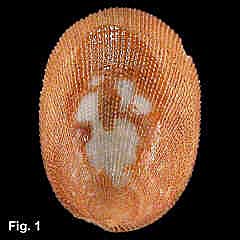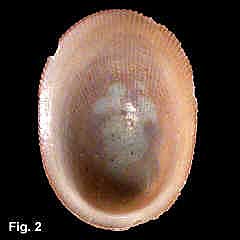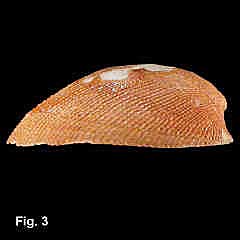|
|
|
|
|
Cinnalepeta cinnamomea (Gould, 1846) Description: Shell thin, lightweight, semitranslucent; oval in outline, widest centrally. Apex at or slightly overlapping posterior margin in adult shells, further forward in juveniles. Sculptured with about 100 fine, scaly radial ribs with flat interspaces between, about 3-4 times as wide as ribs. Internal muscle scar poorly defined. Colour white or fawn, covered with a fawn, brown or black periostracum. Size: Up to 15 mm in length. Distribution: Known from Australia and New Caledonia. In Australia, one record from Cooktown, Queensland; then Moreton Bay, Queensland, southwards to Sydney, NSW. Habitat: Restricted to muddy conditions in estuaries. Early workers considered it a rare species, as recorded by Hedley (1917): "Rather rare; it occurs in Sydney Harbour under large stones in the mud zone, in communities of a dozen or so under the same rock". Coleman gave a more precise habitat: "It lives subtidally in estuarine conditions and can be found beneath rocks or rubble on muddy bottoms at depth of two meters. Common" (Coleman, 1975). Synonymy: Scutellina ferruginea H. & A. Adams, 1854 is a synonym. The name Cinnalepeta escensa Iredale, 1929 was assigned to specimens from the Annan River, south of Cooktown, Queensland. These were described as having closer ribs, and a different shape with the apex more posterior. Cinnalepeta vagans Iredale, 1929 was assigned to New Caledonian shells, described as "larger and proportionately narrower, with more numerous ribs and more pronounced prickles". The relation of these species to the NSW species is still unknown. Remarks: The external anatomy was described by Hedley (1917). Figs. 1,2,3 Port Jackson, NSW (C.166163) |


